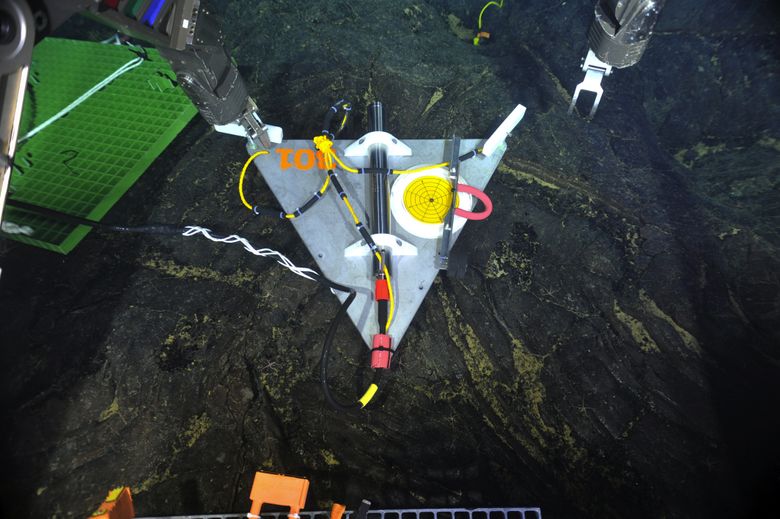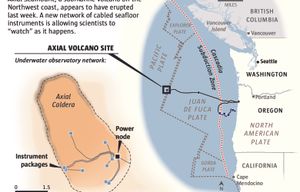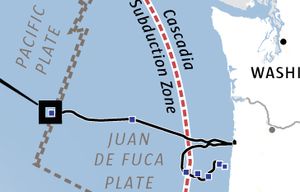More than 80 scientists from around the world gathered in Seattle last week to discuss a thrilling development: For the first time, seafloor instruments were providing a real-time look at the most active, submarine volcano off the Northwest coast — and all signs indicated it might erupt soon.
But even the researchers most closely monitoring Axial Seamount were stunned by what happened next.
“All the alarm bells were going off,” said Oregon State University volcanologist Bill Chadwick, who along with a colleague predicted last year that the volcano would erupt in 2015. “It was very exciting.”
Scientists are still debating whether to describe what transpired as an eruption, which means molten rock flowed onto the seafloor. No instruments were destroyed and there was no obvious temperature spike, so the magma might have oozed into subterranean fissures, forming what’s called a dike.
Chadwick is among those who suspect lava did burst out, probably north of where the new instruments are clustered. “This was a major event,” he said. “A lot of magma moved, and that makes a lot of us think it had to erupt somewhere.”
The only way to find out for sure is to visit the site with a research vessel, which he and his colleagues will do this summer.
But despite the ambiguity, the ability to monitor the submarine upheaval as it unfolded marks a major milestone for the United States’ first underwater observatory. Operated by the University of Washington and completed last fall, the $200 million network includes 600 miles of coaxial cable on the seafloor that powers and delivers data from scores of seismometers, tilt meters, microbial samplers and other instruments.
UW oceanographer John Delaney first proposed the system nearly two decades ago, and is delighted to finally see the vision realized — and bearing scientific fruit.
“It’s like Christmas squared,” he said. “This proves beyond a doubt the value of the cable and the data that’s flowing ashore.”
Topping out at about 3,000 feet high, Axial is more like Hawaii’s shield volcanoes than the Cascades’ towering cones. It straddles the Juan De Fuca Ridge— a seam in the ocean bottom where magma wells up and fresh seafloor is born.
Most of the instruments are concentrated in the volcano’s central caldera, which is nearly 2 miles wide and 5 miles long. The caldera is also dotted with hydrothermal vents and fantastical chimneys called black smokers, which Kelley has studied for years, along with the communities of tube worms and heat-loving microbes that thrive in the inhospitable conditions.
But Axial isn’t easy to get to. It lies under nearly a mile of water and sits almost 300 miles offshore. In the past, Kelley and other scientists had to rely on costly and sporadic research cruises to gather data and deploy temporary instruments.
Though underwater volcanoes pose no hazard to humans, insights gleaned from them might also be applied to volcanoes on land someday, particularly when it comes to the tricky question of predicting eruptions and issuing warnings that can disrupt lives and economies.
Except for the possibility of wounded pride and failed hypotheses, testing prediction schemes on submarine volcanoes is relatively painless, Chadwick pointed out.
“On the seafloor it’s easier to make wild statements because there’s pretty much no consequence to people,” he said.
But even the researchers most closely monitoring Axial Seamount were stunned by what happened next.
Beginning Thursday, April 23 — the day after the workshop ended — the new sensors recorded 8,000 small earthquakes in a 24-hour period. The volcano’s caldera, which had been swelling rapidly from an influx of magma, collapsed like a deflated balloon.
Scientists are still debating whether to describe what transpired as an eruption, which means molten rock flowed onto the seafloor. No instruments were destroyed and there was no obvious temperature spike, so the magma might have oozed into subterranean fissures, forming what’s called a dike.
Chadwick is among those who suspect lava did burst out, probably north of where the new instruments are clustered. “This was a major event,” he said. “A lot of magma moved, and that makes a lot of us think it had to erupt somewhere.”
The only way to find out for sure is to visit the site with a research vessel, which he and his colleagues will do this summer.
But despite the ambiguity, the ability to monitor the submarine upheaval as it unfolded marks a major milestone for the United States’ first underwater observatory. Operated by the University of Washington and completed last fall, the $200 million network includes 600 miles of coaxial cable on the seafloor that powers and delivers data from scores of seismometers, tilt meters, microbial samplers and other instruments.
UW oceanographer John Delaney first proposed the system nearly two decades ago, and is delighted to finally see the vision realized — and bearing scientific fruit.
“It’s like Christmas squared,” he said. “This proves beyond a doubt the value of the cable and the data that’s flowing ashore.”
Topping out at about 3,000 feet high, Axial is more like Hawaii’s shield volcanoes than the Cascades’ towering cones. It straddles the Juan De Fuca Ridge— a seam in the ocean bottom where magma wells up and fresh seafloor is born.
Most of the instruments are concentrated in the volcano’s central caldera, which is nearly 2 miles wide and 5 miles long. The caldera is also dotted with hydrothermal vents and fantastical chimneys called black smokers, which Kelley has studied for years, along with the communities of tube worms and heat-loving microbes that thrive in the inhospitable conditions.
But Axial isn’t easy to get to. It lies under nearly a mile of water and sits almost 300 miles offshore. In the past, Kelley and other scientists had to rely on costly and sporadic research cruises to gather data and deploy temporary instruments.
Though underwater volcanoes pose no hazard to humans, insights gleaned from them might also be applied to volcanoes on land someday, particularly when it comes to the tricky question of predicting eruptions and issuing warnings that can disrupt lives and economies.
Except for the possibility of wounded pride and failed hypotheses, testing prediction schemes on submarine volcanoes is relatively painless, Chadwick pointed out.
“On the seafloor it’s easier to make wild statements because there’s pretty much no consequence to people,” he said.







No comments:
Post a Comment